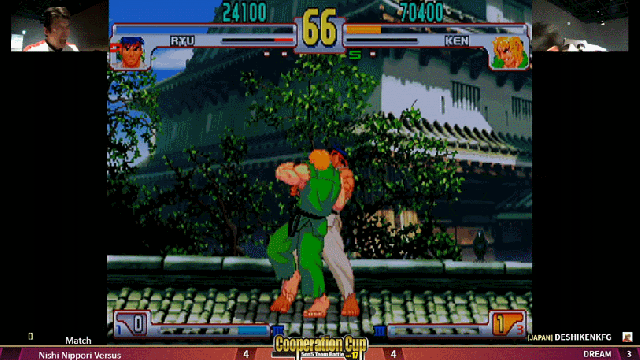Cooperation Cup, a massive Street Fighter III: 3rd Strike team tournament held in Tokyo every year, stands out from the pack because of its punishing and exciting tournament format.
The event got 2019 started right this past weekend with two days of fantastic competition featuring over 500 players, grouped into teams of five for a grand total of 102 teams. The gruelling format provided viewers with a constant stream of pure, unadulterated gameplay.
While most events across the globe have trended towards lengthy, one-on-one brackets, Japanese team competitions continue to be the greatest source of excitement thanks to just how brutal the format can be. The chief supporter of these types of events is an old-school competitor and arcade owner named Yasuaki Matsuda, who in addition to organising Cooperation Cup also helps runs national tournaments for games like Hokuto no Ken, Super Street Fighter II Turbo, Vampire Saviour, and Garou: Mark of the Wolves.
He doesn’t mess around when it comes to these events: Cooperation Cup owes its prestige just as much to the unforgiving ruleset as it does the level of competition it attracts.
This year, Cooperation Cup split its teams into blocks, which were then played round-robin. The winners of each block immediately qualified for the finals, runners-up moved onto separate playoff brackets, and the rest were eliminated. Unlike many events, where players are able to lose once before facing elimination, Cooperation Cup gave each team one shot to defeat their opponents.
No lower bracket, no resets. Competitors faced off in a single game, remaining on deck as long as they kept winning, and teams moved on once they defeated every player on the opposite team. This format is difficult since it affords very little time (just one game of two 99 second rounds) to adapt and learn one’s opponent.
It wasn’t unusual for players to step up to the cabinet and play well only to see their chances disappear in an instant to a devastating Makoto series.
The playoffs were even more unforgiving. Unlike the group stage, teams that made the playoffs selected a single player on which to pin all their hopes. That competitor was then entered into a bracket where they played against other solo opponents. The one-and-done format remains, turning the tournament into a slew of cutthroat single matches.
With multiple Street Fighter III: 3rd Strike cabinets running on stage this year, the broadcast became a rapidly shifting series of vignettes. After watching one player lose, the stream would immediately switch to another cabinet where, sometimes, the match was already completed.
The playoffs are where Cooperation Cup’s strengths really began to shine. With more and more involvement from outside sponsors, modern fighting game tournaments have begun to utilise what the community calls “esports breaks,” or consistent advertising blocks that break up the competition. These breaks serve multiple functions, like giving commentators a chance to stretch or use the restroom and allowing organisers to set up for the next series of matches.
In the meantime, though, the folks watching the stream at home are often subjected to a barrage of commercials that, unfortunately, tend to break up an event’s momentum.
Cooperation Cup still had advertisements, but it was very clear that tournament footage took priority. Breaks were taken between rounds, not in the middle of the action.
As the event moved into its playoffs, there were no more breaks; viewers were treated to a rapid-fire series of matches where the commentary teams gave up on trying to figure who exactly was playing and simply provided raw analysis of the footage at hand.
This tempo is unique to team tournaments in Japan, and while it can be frustrating if you’re trying to follow brackets or keep detailed information on who is playing, it results in one of the most exciting spectacles that the fighting game community has to offer.
Once the weekend of brutal competition came to its close, a self-titled Dream team made up of Street Fighter gods and former winners became Cooperation Cup champions. Deshiken, Shinya “Nuki” Onuki, Kenji “KO” Obata, Issei Suzuki, and Tatsuya Haitani walked away as this year’s strongest Street Fighter III: 3rd Strike players, and their group celebration showed just how happy they were to win this prestigious event.
More than anything else, Cooperation Cup is a celebration of the competitors that continue to play a 20-year-old game, with a format that both challenges its participants and entertains folks watching at home.
If you want more Cooperation Cup action, be sure to check out the official archives.

Comments
One response to “Cooperation Cup’s Brutal Format Makes It Pure Street Fighter III: 3rd Strike Bliss”
I was watching Maximilian_Dood’s restream of this for some of last weekend. It was fantastic, and I’d forgotten how insanely technical 3S is.